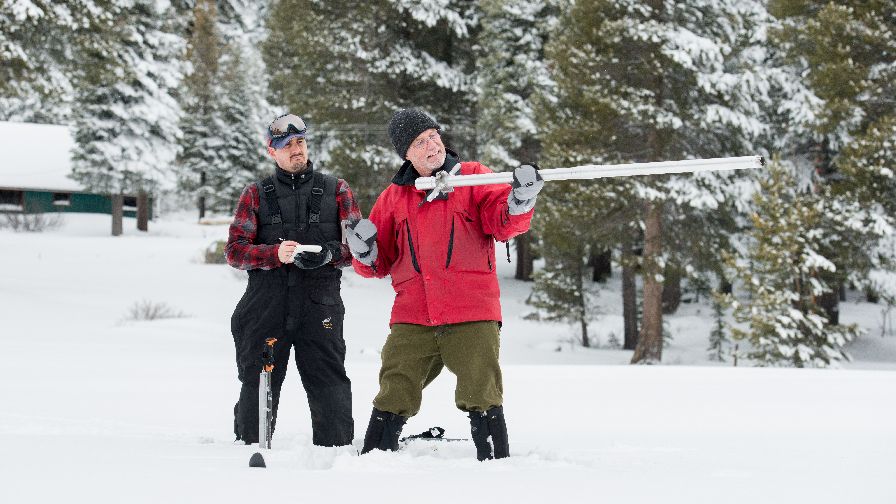California Snowpack Below Average – For Now

From left, John Paasch, California Department of Water Resources, Chief of Flood Operations, and Frank Gehrke, California Department of Water Resources, Chief of Snow Surveys, conduct a manual snow survey Jan. 3 at Phillips Station, CA, just off Highway 50 near Sierra-at-Tahoe Road approximately 90 miles east of Sacramento. (Photo credit: Florence Low, California Department of Water Resources)
Tuesday’s Department of Water Resources (DWR) manual snow survey was disappointing, with a water content of about half the average for this time of year, but state officials remain optimistic as a series of storms are expected to dump several feet of snow in the Sierra Nevada Mountains in the next week.
Frank Gehrke, chief of the California Cooperative Snow Surveys Program, took the measurement at Phillips Station in the Sierra Nevada range, and found a snow water equivalence of 6 inches. That’s 5.3 inches less than the average early-January snow water equivalence of 11.3 inches as measured at Phillips since 1964.
Snow water equivalence is the depth of water that theoretically would result if the entire snowpack melted instantaneously. That measurement is more important than depth in evaluating the status of the snowpack.
More telling than a survey at a single location, however, are DWR’s electronic readings Tuesday from 105 stations scattered throughout the Sierra Nevada. Measurements indicate the water content of the northern Sierra snowpack is 7.2 inches, 68% of the multi-decade average for the date. The central and southern Sierra readings are 7.4 inches (65% of average) and 6.6 inches (73% of average) respectively. Statewide, the snowpack holds 7.2 inches of water equivalent, or 70% of the Jan. 3 average.
But even more important, Gehrke emphasized forecasters predict a series of wet cold storms stretching into next week. “That’s going to bolster the snowpack,” he said. “I can see us being potentially at average once that series of storms moves through. I think it’s a very encouraging start to the winter, and certainly we’ve had other winters when (Phillips) has been basically a bare field.”
In addition, January and February are two of California’s three historically wettest months, which means the readings taken today at Phillips during the winter’s first snow survey – a traditional show for TV cameras – are a key starting point of information but don’t shed much light on how wet the wet season ultimately will be.
The Phillips snow course, which is near the intersection of Highway 50 and Sierra-at-Tahoe Road, is one of hundreds that will be surveyed manually throughout the winter. Manual measurements augment the electronic readings from about 100 snow pillows in the Sierra Nevada that provide a current snapshot of the water content in the snowpack.
State Climatologist Mike Anderson said about half of California’s annual rainfall occurs in December, January, and February and about two-thirds of the annual total arrives during December through March. Total precipitation so far this water year, which began Oct. 1, has been above average, but warm temperatures during storm events have tended to cause precipitation to fall as rain rather than snow in many mountain locations.
“We still have three historically wet months ahead of us,” Anderson said, “so there’s still time for the snowpack to build and improve before it begins to melt, which usually starts happening around April 1.”
Acting DWR Director Bill Croyle said above-average precipitation since the start of Water Year 2017 in October added significantly to storage in 154 reservoirs tracked by the department. Croyle said DWR has estimated total storage at the end of December at 21.5 million acre-feet (MAF), 98% of the reservoirs’ historical average of 21.9 MAF on Dec. 31.
Lake Shasta, California’s largest surface reservoir, now holds 118% of its historical average. One year ago, Shasta’s storage was just 50% of its average. Similarly, Lake Oroville, the State Water Project’s largest reservoir, holds much more water today than a year ago – 91% of its historical average compared to just 47% one year ago.
“Precipitation and storage are doing quite well compared to the past 5 years of historic drought conditions,” Croyle said, “and that makes us cautiously optimistic about water conditions, although some areas in California are still hit hard by the drought and require a response. The snowpack is clearly lagging below its early-January average, but we have many more snow courses to measure this winter before we’ll know whether this water year has had a significant positive effect on the drought.”
DWR conducts five media-oriented snow surveys each winter – near the first of January, February, March, April, and May – at the Phillips Station plot. On average, the snowpack supplies about 30% of California’s water needs as it melts in the spring and early summer. The greater the snowpack water content, the greater the likelihood California’s reservoirs will receive ample runoff as the snowpack melts to meet the state’s water demand in the summer and fall.
The snow surveys have been getting extra attention since Gov. Edmund G. Brown Jr. declared a drought State of Emergency in January 2014. There was no snow to survey at Phillips Station that month, and Brown directed state officials to take all necessary actions to prepare for water shortages. California has experienced five consecutive water years of drought conditions and is three months into a possible sixth consecutive year.









